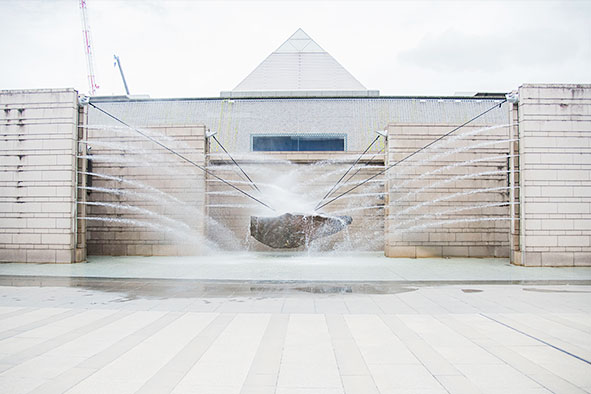Bonus Towers Near Tokyo
Warning: True Tower Fanatics Only
Tokyo Skytree
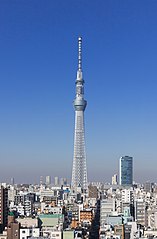
Yes, perhaps you’ve noticed it already, as it’s not really an obscure “true tower fanatics only” tower, but there’s one glaring omission from the All-Japan Tower Association (and Stamp Rally): The Tokyo Skytree. Why isn’t it in the Association? I’m not sure and did not research it at all, but maybe it’s just too high-and-mighty for the piddly little towers in the Association. After all, it’s literally the tallest tower in the world right now, almost twice as tall as Tokyo Tower. It’s still quite new, it’s hip, it’s flush with cash (I assume), they had the financial foresight to build a giant mall at its base, and finally, for the time being it doesn’t need to rely on silly gimmicks like a "stamp rally” to attract hordes of fawning tourists. But, a decade or two from now, maybe after they’ve built a tower twice as high somewhere currently towerless like Kawasaki, the washed-up Skytree is going to come crawling to the humble Tower Association and beg to be let in. Until then, you can visit the shiny new Skytree to feel what the atmosphere was like at Tokyo Tower in the sixties, or at the other towers when they were still young and hot.
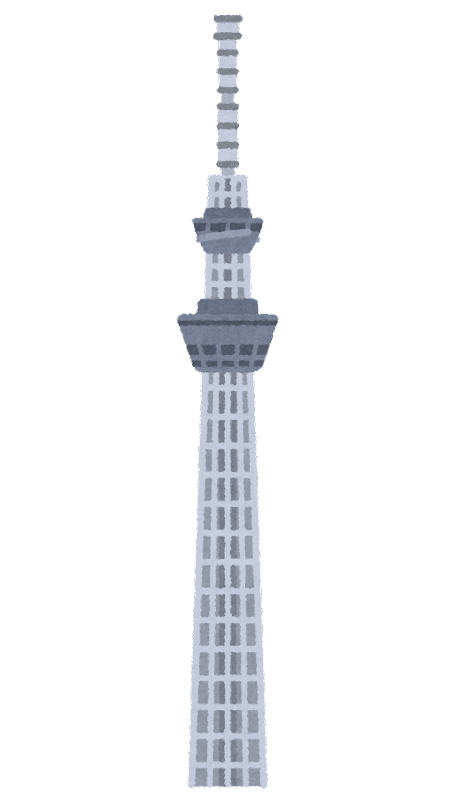
The Skytree may be the tallest tower in the world, but it feels even taller thanks to its prominence. It’s basically the Mount Fuji of towers. This is mainly because there are no other skyscrapers or tall buildings in its vicinity, other than the modest one that’s at the other end of the Skytree complex. Earlier, I speculated that perhaps a lot of towers were built in industrial port areas because people didn’t want big towers in their backyards, but the Skytree complex is like a volcanic island that popped up in the middle of a huge residential district. I feel like the people living in those modest 3-4 story houses all around it must constantly feel a vague sense of unease, with the Skytree intimidatingly looming above. I think it might be the most striking contrast in terms of neighboring building heights that you can find in the world. I can already imagine some scientist or analyst looking at a dataset of all the building heights in that area of Sumida City, and throwing out the Skytree’s data point as an obvious error or outlier.
Also, within brief walking distance of the Skytree, in the direction of Asakusa, you can see some other... unique architecture. I am speaking of the Asahi Breweries headquarters, situated on the riverbank. The main skyscraper office building is built to look like a mug of beer, and I admit it does actually pull it off quite well. The glass on the outside is an appetizing golden beer color, and it’s topped off by some jagged white bits that suggest a nice froth. Unfortunately, this success is mostly overshadowed by the real show-stealer right next to it: the Golden Turd building. It’s a large, all-black building that seems shaped somewhat like pedestal to carry and display its precious charge for all to see: a gigantic Golden Turd. Apparently, it is supposed to be a flame representing the “burning heart of Asahi beer”, but the fact that it is sideways rather than standing straight up makes it almost impossible to see as anything other than a golden turd, or perhaps carrot. I don’t know if this is true, but I believe a Japanese person once told me that the Golden Turd was indeed originally supposed to be placed standing up straight like a flame, however once they had finished the Golden Turd, they found out that it was against building safety regulations to stand it up like that, so they were forced to just lay it down like a big steaming log on top of its pedestal. Of course, with the way some modern architecture has been going, I wouldn’t be entirely surprised to find out that it had been designed like this from the get-go. At the very least, we can’t say that they didn’t succeed in making one of the city’s most distinctive buildings.
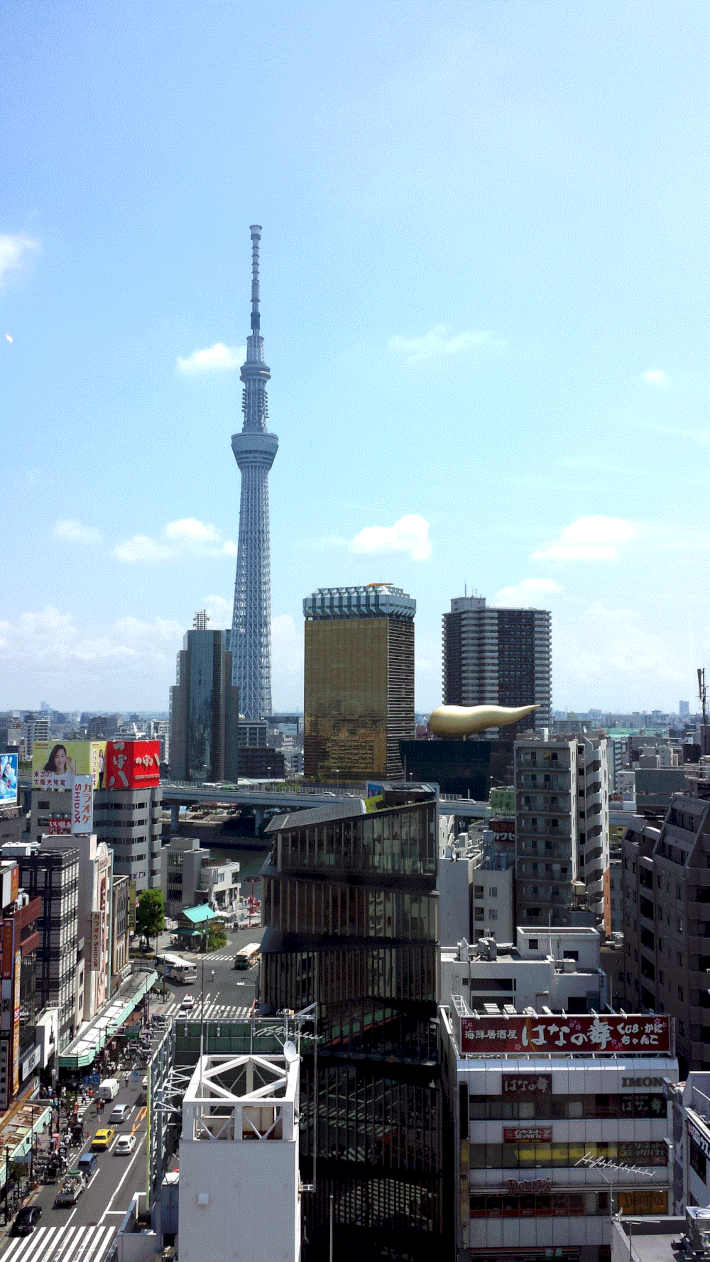
Enoshima Sea Candle
Listen up, suspended monorail fans, here’s another one for you. When most people think of Enoshima, the tidal island near Kamakura, what immediately comes to mind is the picturesque little Enoshima Electric Railway. You’ve probably already seen some liberally-filtered pictures of it, rustic green and beige electric train cars running beside the ocean. But what you hear about more rarely (or see) is the magnificent SUSPENDED MONORAIL that runs from Ōfuna station to Enoshima as well. The Shonan Monorail, as it’s called, is so overflowing with SOUL that it’s practically poisonous to a cynic like me. Their website has a cute little monorail graphic that goes back and forth across the top of the page every so often, infographics and maps explaining that taking the monorail is both 20 minutes faster and 90 yen cheaper than taking the Enoshima Electric Railway, detailed specs about the various monorail models, smiling pictures of the staff, and even information about a children’s book based on the monorail.
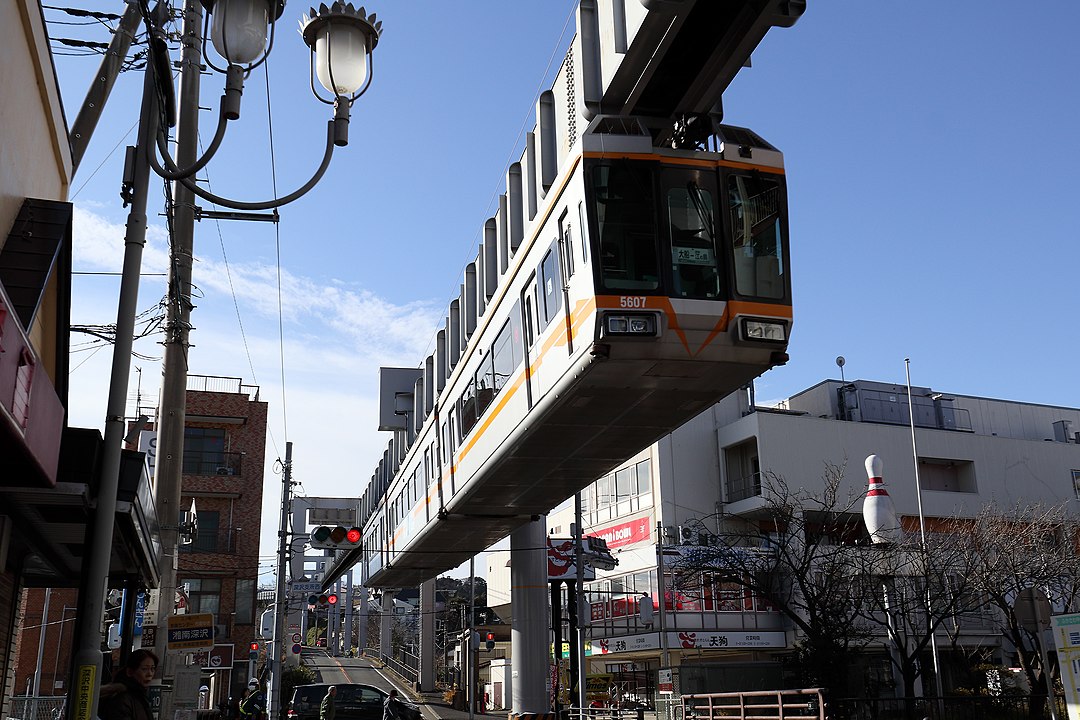
What takes the cake and runs away with it, though, is the WEB MAGAZINE they publish. All of the articles are, to varying extents, inspired by the monorail, but the diversity of the content manages to be unbelievably diverse. Some of it is the sort of stuff you’d expect, like interviews with employees or an impressively long series of posts about the monorail’s history. There’s some series that go a bit deeper, with various experts weighing in on the line’s design details like the station design, signage, or the route maps. There are also quite a few series where artists of various types (writers, illustrators, photographers, game developers, etc.) create works inspired by riding the monorail. Then, there’s the stuff that really goes off the rail, where they bring in various people from the Japanese internet with odd interests and just have them do their thing, riffing off the monorail. For example, they bring in a guy who takes pictures of staircases under the auspices of the “Tokyo Staircase Research Society” and posts them on a blog called “Tokyo Staircase Database”, and he writes a whole series where he tries to find staircases in the area that have the best view of the monorail. Another guy writes about his quest to draw a giant, 2-kilometer goat on GPS by walking around the area, and of course using the monorail line for part of the neck/back. Somehow, he also manages to enlist 20 other people from Twitter to do it with him.
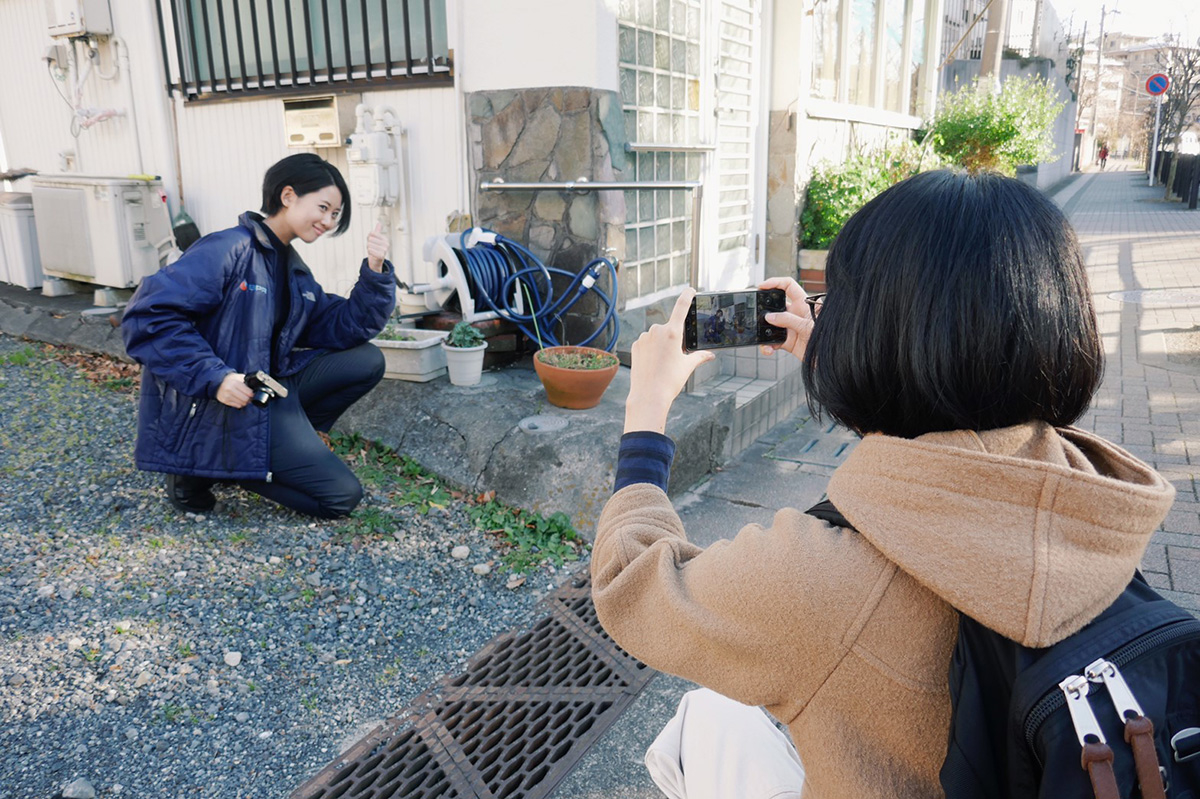
All in all, I must say that the Shonan Monorail web magazine is the very model of corporate artistic patronage. I want to believe in it all so badly, I want it all to be real, but the skeptic in me can’t help but think of the possibility that it’s all marketing, it’s all PR, it’s all fake. After all, the Japanese are notorious for their dedication to keeping up appearances to save face. At the very least, if my enthusiasm for the monorail is genuine, then surely there are others as well... I can’t believe how emotional I am getting over a goddamn suspended monorail line that takes just under 15 minutes to ride from end to end. This is going to end with me having a breakdown riding the monorail someday, wailing “I want to believe...”
The Shonan Monorail is actually the only suspended monorail I’ve ever been on before, a truly transcendent transit experience. The unique viewpoint you get from inside the suspended monorail, of floating just above the city, is not something you can easily experience in person any other way. The route also seems to have been designed by amusement park engineers to deliver gentle turns and a few dramatic curves, which they tout as a big selling point in a lot of the marketing material: “It’s just like a roller coaster”. The best part in my opinion, though, is the tunnels. Yes, the Shonan Monorail is the only suspended monorail in the world that goes through tunnels, and two of them at that. It’s such a dramatic contrast, going from floating in the air one minute to tunnelling through a hill. I couldn’t believe my eyes when I saw that we were about to go into a tunnel, since the thought of it seemed impossible, as the very antithesis of the airiness of a suspended monorail. Then, at the end of the second tunnel, you come out into the air again, arriving at one of Japan’s tallest transit stations. It would have a great view of Enoshima from the terrace, if they hadn’t annoyingly built a bunch of tall residential buildings in the way. The whole ride, though only fifteen minutes long, is exhilarating. I remember seeing the schoolchildren riding the monorail to go home and feeling so envious that they get to ride it every day. Then again, that probably makes it feel commonplace...
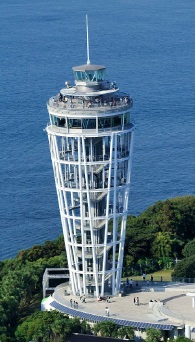
Towers... right.... the Enoshima Sea Candle is on the tidal island of Enoshima, which back in the old days you’d walk across a short sandbar to get to, if the tide was low enough. Nowadays, stability and constant connection is a must, so there’s a pair of bridges, one for cars and one for pedestrians. At the end of the pedestrian bridge, there’s a charming little district of shops and restaurants, of the kind that tends to spring up anywhere in Japan where there’s a walking path to some sort of attraction. From there, the climb up the hill that makes up most of the island begins, shrouded by trees and myriad shrines. It’s a pretty decent hill, I must admit, and one of the traditional shrine-looking buildings on it actually houses a very modern convenience: the only “pay escalator” that I’ve ever seen. At the top of the hill is the Enoshima Sea Candle, which while modest in size, is in fact taller than a couple of the towers in the Tower Association. Many of the other towers are also by the ocean, but the Enoshima Sea Candle is the only one that serves as a lighthouse as well. Hence the “candle” in the name, I suppose. I was unfortunately too cheap to actually go up in the Sea Candle when I visited Enoshima, deciding instead to save my money for the sea caves that lay on the other side of it. Then they ended up being closed due to damage from some typhoon or something, so I guess now I’ve got more than enough reasons to make a return trip.
Ōarai Marine Tower
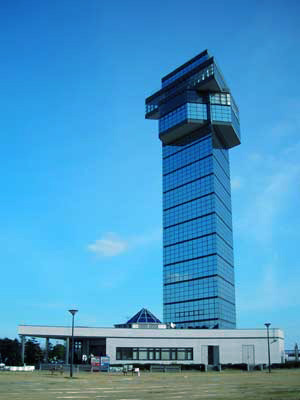
Tower fans watching popular sports anime “Girls und Panzer” were certainly left wondering: is that tower that appears near the port in a few episodes real? In fact, it is: it’s the Ōarai Marine Tower, a shockingly robust tower for the size of the town. The design looks pretty modern, although the observation decks up top remind me of a twisted Rubik’s cube. The only issue with that assessment is that the tower’s footprint is decidedly triangular, though now that I think about it, I’m pretty sure nowadays many puzzle “cubes” are really quite far from being cubic. Won’t be long before we see one that’s a tesseract, I’m sure. Anyways, this tower is certainly pushing the “Near Tokyo” designation as well (despite being a bit further than Choshi, though, the travel time by train is a bit less), but no doubt scores of Garupan fans have made a daytrip pilgrimage to Ōarai. They’ve almost certainly visited the tower, too, since it has a themed café on one of the floors, and it’s not as if there’s a whole lot to do in Ōarai.
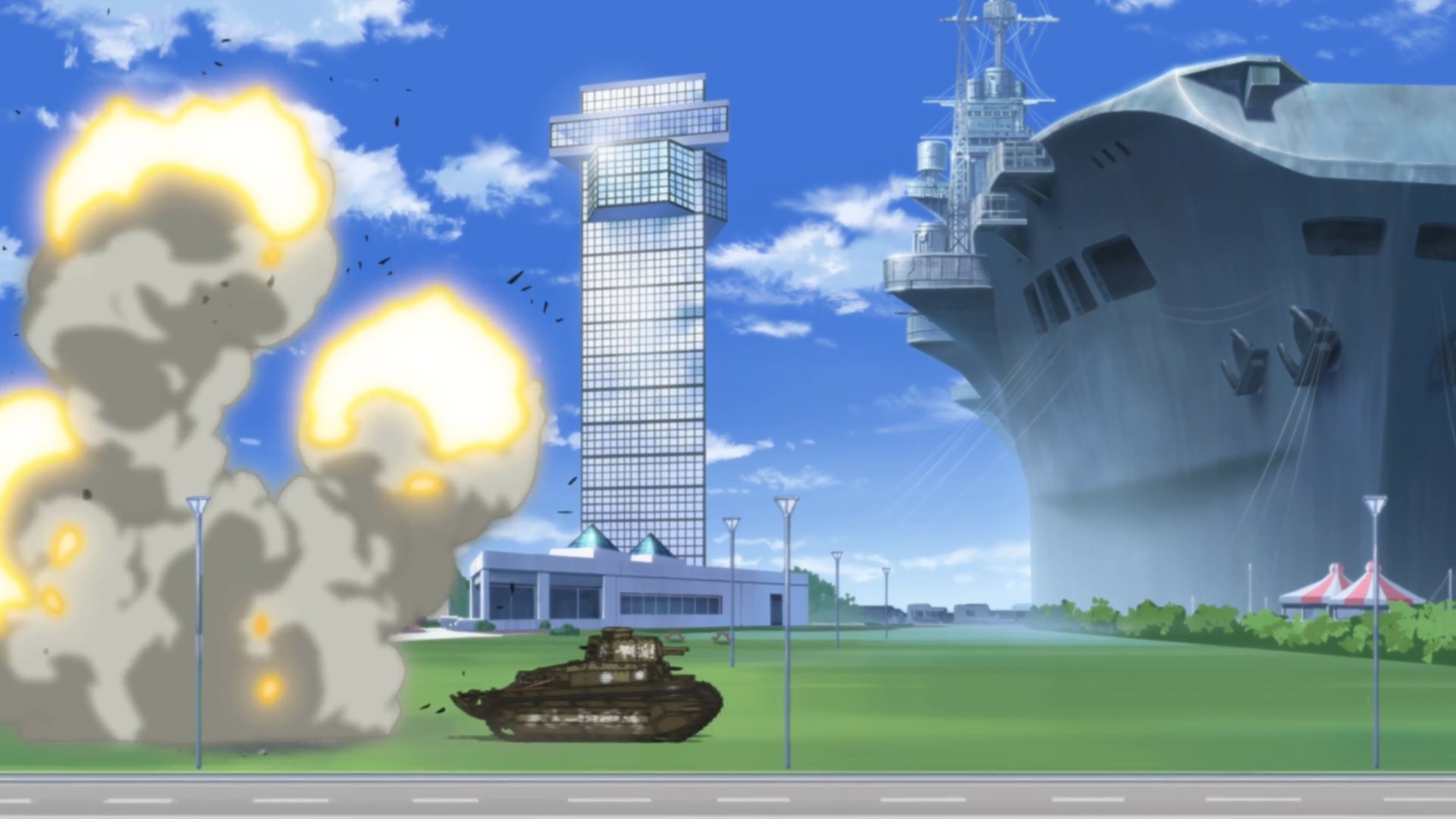
Art Tower Mito
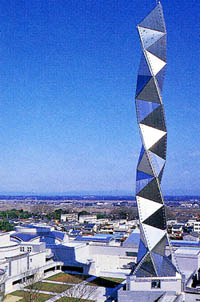
While you’re making your inevitable pilgrimage to Ōarai Marine Tower, you will almost certainly have to transfer trains in the nearby bigger city of Mito. As it so happens, there is a tower in Mito as well, and it happens to be one of the most unique in the country. Many towers are built for tourism, quite a few are built for various broadcasting purposes, but the tower in Mito stands apart as a tower built for art (and also tourism). Hence the name “Art Tower Mito”, to ensure that you understand that the tower was not built to lure sightseers, it just happens to do so as a result of being so artistic. I would say that it’s the only tower design I’ve seen so far that could work just as well as an Ikea lamp, which says a lot. The tower also reminds me of the day in third grade when they had us cut out a bunch of paper triangles and try to tape them together into polyhedra. Sometimes the only way to move forward is by going back, I suppose.
The tower itself is the centerpiece of a whole contemporary arts venue for the area, which as a whole seems to be confusingly called “Art Tower Mito”, at least in the English translation. The design of the whole complex is no less eccentric, and some might even say artistic. It’s the absolute pinnacle of eighties/nineties postmodern architecture mixed with Japanese Metabolist influences, from the era just before glass took over all modern architecture. I went on Wikipedia and checked the “Postmodern Architecture” page just to make sure I wasn’t completely talking out of my ass with that one (I am in no way trained in architecture), and what should I see scrolling down the page but a picture of Art Tower Mito in all its glory in the Japan section. I don’t know what else to say about the design of the complex other than it looks like the sort of place where they’d film an episode of Stargate SG-1 set in a city on another planet. Highlights include the fountain that’s mostly just a giant rock suspended a few inches off the ground by cables, and yet another attempt at artificially replicating the accidental success of the Leaning Tower by pedestal the tower sits on at such an angle that it appears it has partially sunk into the ground. The tower itself is probably the least postmodern element of the whole complex, as it looks just a little too raw and industrial. It looks like it might be too thin to actually go up in, but there’s actually enough space within for an elevator, and if you look closely at the top of the tower, you can see the portholes (of course) that are the windows for the observation deck. Unfortunately, the dedication to the schtick comes at the expense of the view, according to reviewers. Oh, the sacrifices we make for art.
